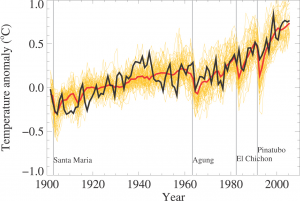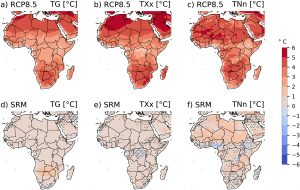Solar radiation management (SRM) could be the only known quick method for stopping the rise of global temperatures at relatively low cost. SRM is a theoretical approach that aims to reduce climate warming by reflecting some sunlight back into space. Several SRM geoengineering technologies exist but two popular techniques currently receiving the most attention include, brightening marine stratus clouds by spraying droplets of seawater into clouds to increase brightness, and mimicking the cooling effect produced by volcanic eruptions, by injecting reflective sulphate aerosol particles into the stratosphere. Similar to the latter technique was the 1991 eruption of Mount Pinatubo in the Philippines, where tons of sulphur dioxide, dust and ash was released into the atmosphere, resulting in an average half degree drop in global temperature (Robock 2000). The cooling effect of volcanoes can be seen in figure 1.

Figure 1 Global mean near-surface temperatures over the 20th century from observations (black) and as obtained from 58 simulations produced by 14 different climate models driven by both natural and human-caused factors that influence climate (yellow). The mean of all these runs is also shown (thick red line). Temperature anomalies are shown relative to the 1901 to 1950 mean. Vertical grey lines indicate the timing of major volcanic eruptions. (Figure from IPCC AR4 CH8).
Temperatures are increasing at a rate that has never been recorded in human history. Anthropogenic global warming is expected to continue during the 21st century as concentrations of greenhouse gases (GHG) in the atmosphere increase. Countries across the world have resolved in the Paris Agreement to limit the increase in global temperatures below 2°C. However, some argue that it is nearly impossible to stay within the 2°C limit. Even if all States fulfill their pledges under the Paris Agreement, warming is approximated to reach 2.7°C by the end of this century (Rogelj et al. 2016). SRM technology is considered a more radical response to combat this rising global temperature. For example, the use of aeroplanes to spray sulphate aerosols into the stratosphere is a relatively inexpensive process. Also, risks associated with aerosol SRM technique are considered reversible as the effects of artificial aerosol injection are temporary and disperse within a few years.
Therefore, SRM could be the answer to the current climate impacts exacerbated by global warming, such as temperature extremes, intensity of tropical storms and melting sea-ice. It could also be a feasible solution to delay catastrophic events related to climate change and ‘buy time’ to allow for a transition into green/renewable energy. SRM could be a good solution to avoid expenses of mitigation and adaptation to climate change. Our World in Data projected that the amount of money to be spent in a year to mitigate climate change is one percent less that the forecasted global GDP in 2030. The high costs of mitigation are undeniable. In any case, SRM can not be the solution to GHG emissions but it is a potential temporary fix.
However, while SRM has been shown to reduce global temperatures, local climate responses, and especially regional precipitation patterns is uncertain. A recent article by Pinto et al. (2020) shows potential impacts of the SRM stratospheric aerosol technique. They used climate model simulations from the Geoengineering Large Ensemble (GLEN) to explore the projected climate response of artificially reducing sunlight in the sub-Saharan Africa, where there is a high vulnerability to climate variability. The paper has a nice framing of potential impacts of SRM in various areas, where ‘Effective’ means that it could reduce the negative impact of global warming, ‘Ineffective’ means it may not reduce the impact, and ‘Counter-effective’ means it could actually actually produce worse impacts. Projected response under increases in GHG and SRM showed a reduction in surface mean temperature across the region (figure 2), and projected changes in precipitation is less uniform across the region but could reduce extreme precipitation (Pinto et al. 2020).
Figure 2 The multimember mean of temporally averaged changes in mean temperature (TG), hottest day (TXx), and coldest night (TNn) by 2051–2080 compared to 1981–2009 under RCP8.5 (a–c) and SRM (d–f). Hatches indicate areas where at least one model does not agree on the sign of the change. (figure from Pinto et al. 2020)
Although SRM technologies seem to be effective in most regions, they come with some adverse health and environmental effects. Sulphur aerosols in the atmosphere produce sulphuric acid depleting the ozone layer and enhancing UV-B radiation, therefore causing some serious health challenges such as skin cancer and damage to eyes. SRM also introduces some ethical and political dilemmas. The most prominent concern is that SRM geoengineering will divert the attention of governments and politicians away from mitigation actions to reduce CO2 emissions and implementing the Paris Agreement. Additionally, the reduction of the amount of solar radiation reaching the earth’s surface could diminish the potential of renewable energy as the solar power is reduced (Smith et al. 2017). Other risks associated with SRM geoengineering involve weather impacts such as disruption of summer monsoon rainfall in China and Africa, which will affect food security and seasonal crop yields.
So far research shows that changes in temperature will not be uniform across the globe. How do Nations decide how much cooling should be allowed? Tropics are more likely to cool but high latitudes would become warm. However, new experiments that combine stratospheric SRM and surface brightening show potential of controlling these regional differences. To sustain cooling, SRM geoengineering technologies would have to be used continually and if suddenly terminated, temperature and Arctic sea-ice melting would increase at a much faster rate than gradual global warming caused by GHG emission. Therefore, once the process starts, there is no way of stopping without disrupting the climate and causing damage to the environment. Future generations would be obligated to continue using SRM geoengineering techniques to ensure a stable climate.
SRM is a temporary solution that addresses an aspect of climate change, which is the rise temperature. If GHG emissions are not reduced, we still run the risk of increasing ocean acidification, as well as air pollution and more respiratory diseases. In no way should SRM geoengineering technology shift the focus from reducing emissions. However, despite the 2015 Paris Agreement to limit the increase in global temperature by reducing GHG emissions, global emissions increased by 1.7 percent in 2017 and 2.7 percent in 2018. The year 2019 is likely to have increased in emissions as well.
Should we rather take the risk of implementing SRM or put all our efforts into mitigation and building resilience?
For further reading on SRM geoengineering:
Pinto, I., Jack, C., Lennard, C., Tilmes, S. and Odoulami, R.C., Africa’s Climate Response to Solar Radiation Management with Stratospheric Aerosol. Geophysical Research Letters, p.e60122
Robock, A. 2000. Volcanic eruptions and climate. Rev. Geophys. 38, 191–219
Rogelj J et al. 2016 Paris agreement climate proposals need a boost to keep warming well below 2°C. Nature 534, 631–639.
Smith, C.J., Crook, J.A., Crook, R., Jackson, L.S., Osprey, S.M. and Forster, P.M., 2017. Impacts of stratospheric sulfate geoengineering on global solar photovoltaic and concentrating solar power resource. Journal of Applied Meteorology and Climatology, 56(5), pp.1483-1497

